The old “send and pray” approach, where you blast emails to your customer list and cross your fingers for a purchase, is no longer enough.
Marketing today is no longer a monologue; it’s a conversation.
That’s exactly where conversational marketing comes in. By enabling two-way, real-time interactions, it’s transforming e-commerce and is projected to drive a global market worth over $290 billion by 2025.
And no channel powers these conversations better than WhatsApp, which has open rates reaching 98%. In this guide, we’ll break down the basics of WhatsApp conversational marketing, proven strategies, and real-world examples to help you get started.
What is WhatsApp Conversational Marketing?
Conversational marketing is about creating real, two-way dialogues with customers, not sending the same message to everyone.
Unlike bulk emails that push promotions, conversational marketing builds relationships through in-app chats, SMS, and social channels like Instagram or Facebook.
On WhatsApp, it goes even further. Customers can ask about products, get personalized recommendations, receive order updates, apply discounts, and even complete checkout within a single conversation. It’s like having an in-store assistant helping them out, only now right on their phone, available 24/7.
What makes this powerful is its immediacy, clarity, and the fact that it happens on platforms customers already use daily. Beyond conversions, it humanizes the brand, fostering trust and loyalty. That’s why companies using conversational marketing are seeing up to 10x higher conversions.
Why Conversational Marketing on WhatsApp Works
Now that we understand conversational marketing, let's explore why WhatsApp is the leading medium for it. Here is why it works so well:
High Engagement Rates
As we mentioned before, WhatsApp boasts the highest message open rate compared with other platforms. This increases the chances of customers reading the messages and acting upon them. In fact, implementing WhatsApp chatbots can boost lead generation by over 500%, demonstrating the platform’s potential in sales and marketing.
Builds Trust and Loyalty
A two-way conversation feels more personal than a mass message. When customers can ask questions, get instant answers, and even receive personalized recommendations, it humanizes your brand. Over time, this consistency builds trust and long-term loyalty.
Enables 24/7 Customer Interaction
Customers expect brands to be available based on their convenience. WhatsApp makes it possible with chatbots and automated replies that offer round-the-clock assistance, answering FAQs, tracking orders, or resolving issues instantly.
Facilitates In-Chat Sales and Support
WhatsApp takes conversational marketing a step further with conversational commerce. Customers can browse products, apply discounts, get support, and even complete their purchase, all without leaving the app. This feature reduces friction and keeps customers engaged.
Curious about WhatsApp marketing costs? Check out our complete guide to learn what drives the pricing, the key factors that influence it, and smart ways to save.
10 Proven WhatsApp Conversational Marketing Strategies
Here are 10 proven strategies to help you make the most of WhatsApp conversational marketing:
1. AI-Generated Carts
AI can use customer conversations to build a personalized shopping cart inside WhatsApp automatically. Customers don’t need to browse endlessly; instead, they receive a ready-to-checkout cart with products tailored to their needs.
To implement this, simply integrate your WhatsApp Business API with an AI-powered commerce tool. All you have to do then is to train the bot to suggest products based on customer queries and generate dynamic carts with payment links.
Example: A sports retailer like Decathlon can use AI carts to recommend a complete workout kit (yoga mat + resistance bands + dumbbells) after a customer asks about “fitness gear for home workouts”.
Pro Tip: Add urgency by pairing AI-generated carts with a time-limited discount or free shipping offer to nudge undecided shoppers to act fast.
2. Cart Recover With Two-Way Conversation
Cart abandonment is one of the biggest leaks in e-commerce, and WhatsApp conversational marketing solves it with real-time, two-way engagement.
Instead of sending a bland reminder email that often gets ignored, you can trigger a personalized WhatsApp message when a cart is left behind. This way, customers can actually reply, ask questions about shipping, sizes, or discounts, and get answers instantly. As a result, shoppers feel supported throughout the decision-making process.
Example: An online beauty store, Nykaa, notices a customer checked out a hair serum but didn’t complete the purchase. The AI instantly sends them a WhatsApp message asking about their hair concern to provide a personalized list of serums.
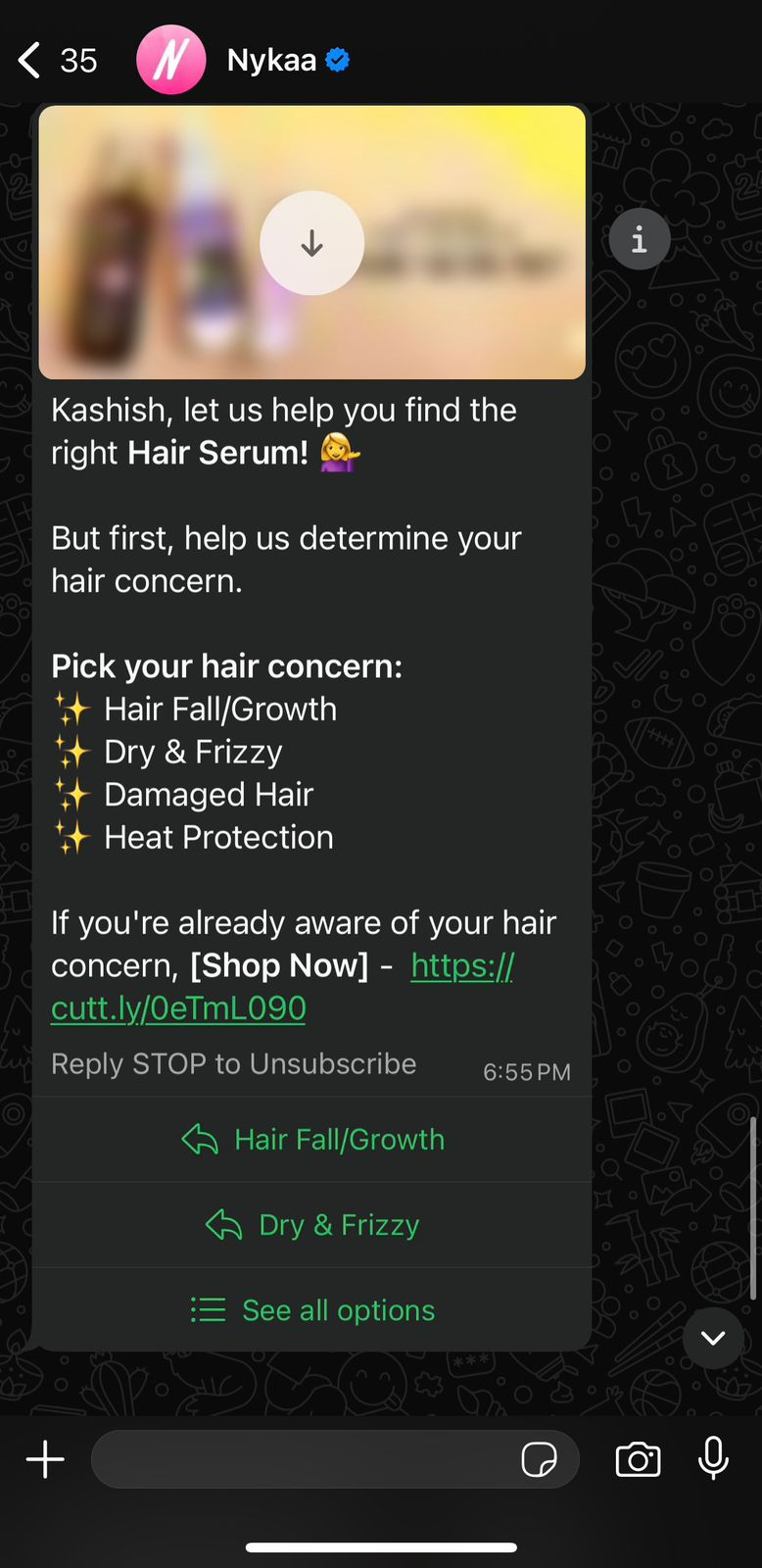
Pro Tip: Send the cart recovery message within an hour of abandonment, when purchase intent is still fresh.
3. Guided Shopping with In-Chat Catalogs
Customers often need a little guidance before making a purchase, whether it’s exploring products in a specific price range or browsing collections from a favorite designer.
Guided shopping with in-chat catalogs makes this process effortless by allowing customers to scroll through curated options, compare styles, and even ask questions within WhatsApp.
Instead of clicking static product links, shoppers experience a dynamic catalog that feels like a personal stylist guiding them.
Example: Aza Fashions, a luxury apparel brand, uses WhatsApp marketing to share curated collections tailored around specific designer labels. Instead of browsing through hundreds of products, customers receive direct access to the newest collections from their favorite designers.
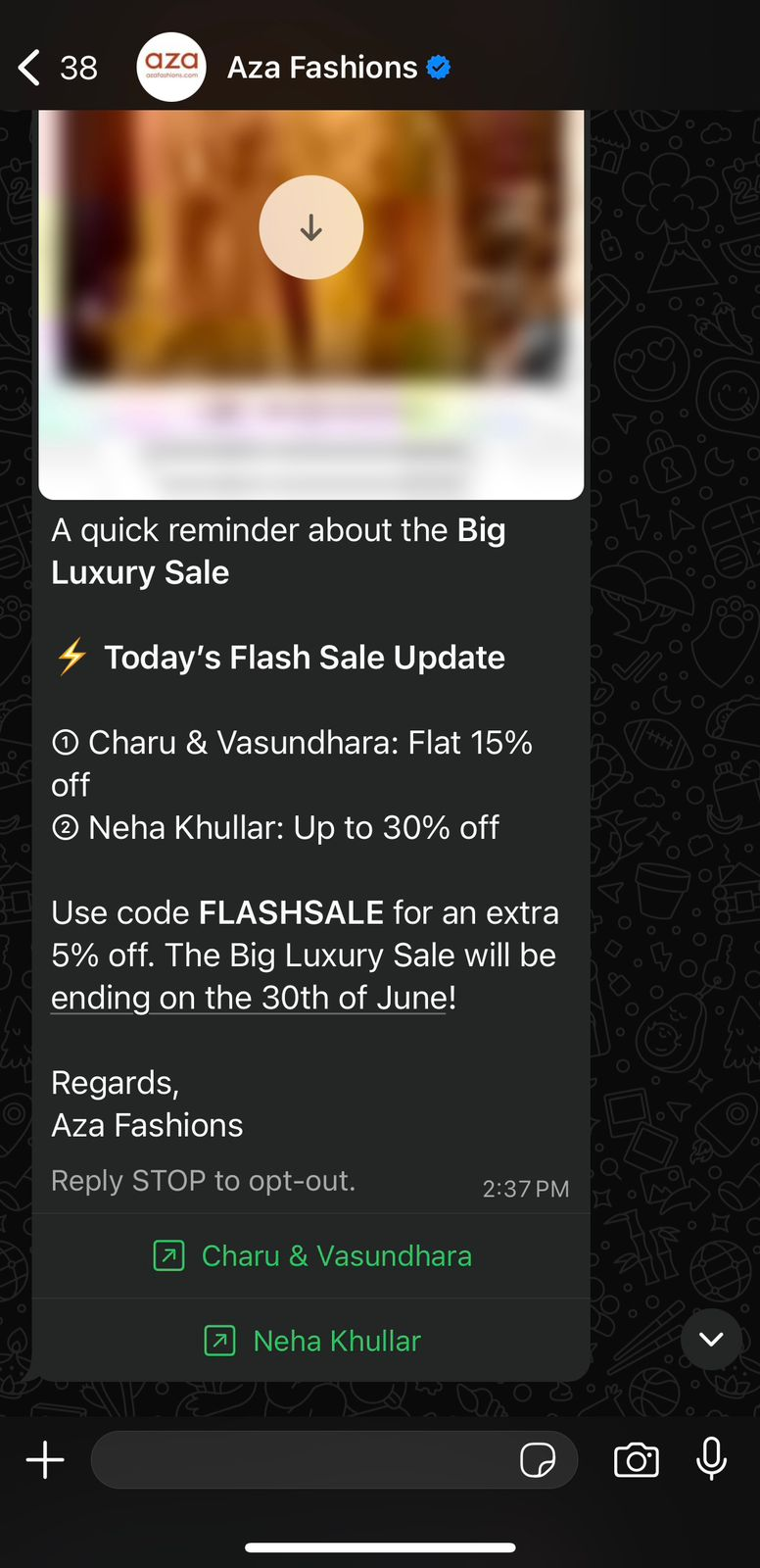
Pro Tip: Use quick-reply buttons like “Show me more” or “Filter by budget” to make the shopping experience feel conversational.
4. One-Tap / Low-Friction Checkout
Customers often find what they need but leave it in the cart itself. This incomplete purchase may be due to time constraints or a reluctance to make the effort to be redirected and then pay.
To solve this, businesses can offer one-tap checkouts on WhatsApp that allow customers to complete purchases without switching apps or filling endless forms. With saved details like address and payment info, the buying journey shrinks to just a tap, making impulse buys and repeat purchases effortless.
Example: Uncover Skincare shares a WhatsApp cart with a “Buy Now” button. The customer taps once, confirms payment, and gets an instant order confirmation without leaving the chat.
Pro Tip: Integrate secure payment gateways directly into WhatsApp to build trust and ensure customers feel safe making quick transactions.
5. Gamified Broadcasts Inside WhatsApp
Marketing is not solely about sending customers their abandoned carts or a discount announcement. You can make it more fun and engaging for your customers with gamified podcasts that include spin-the-wheel offers, scratch cards, or quick surveys, which make interactions exciting.
Example: Famous fashion brand, Levi's, sent out a contest message to its customers offering them free tickets to the show of a renowned singer, Diljit Dosanjh. All they had to do was answer a few questions and make a purchase.
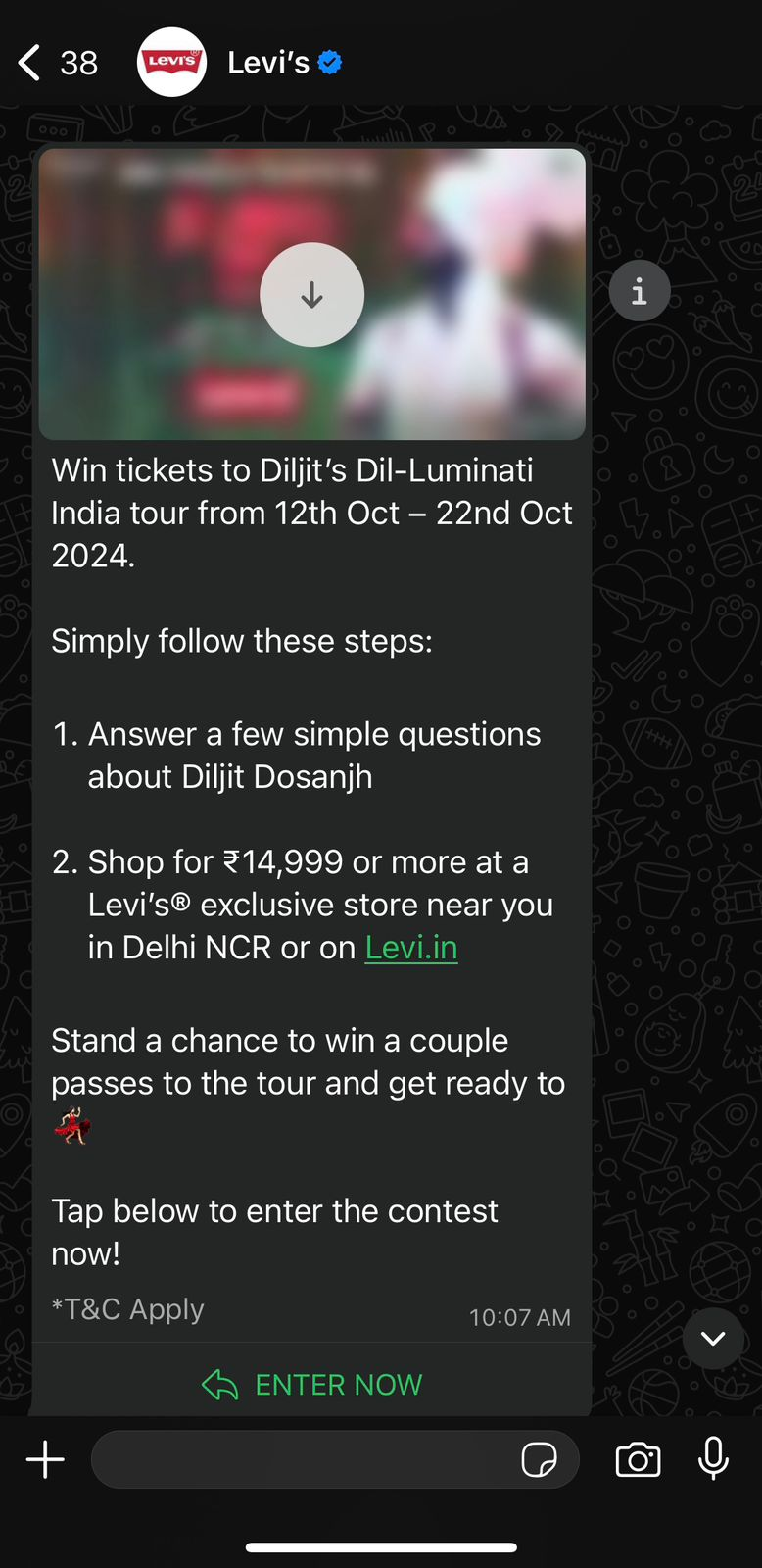
Pro Tip: Keep gamification simple and reward-driven. The faster customers see value, the more likely they are to participate and convert.
6. Loyalty and Rewards Inside WhatsApp
Keeping customers coming back is just as important as getting them to buy once. With loyalty and rewards programs built into WhatsApp, brands can remind shoppers of their points, share exclusive perks, and even let them redeem rewards directly in chat.
This creates a sense of exclusivity and keeps customers engaged with the brand long after their first purchase.
Example: Zepto, a quick-commerce app, keeps customers hooked with real-time WhatsApp updates. Whenever Zepto Cash is credited to a user’s account, they instantly get a message highlighting the amount earned and how it can be redeemed on their next purchase.
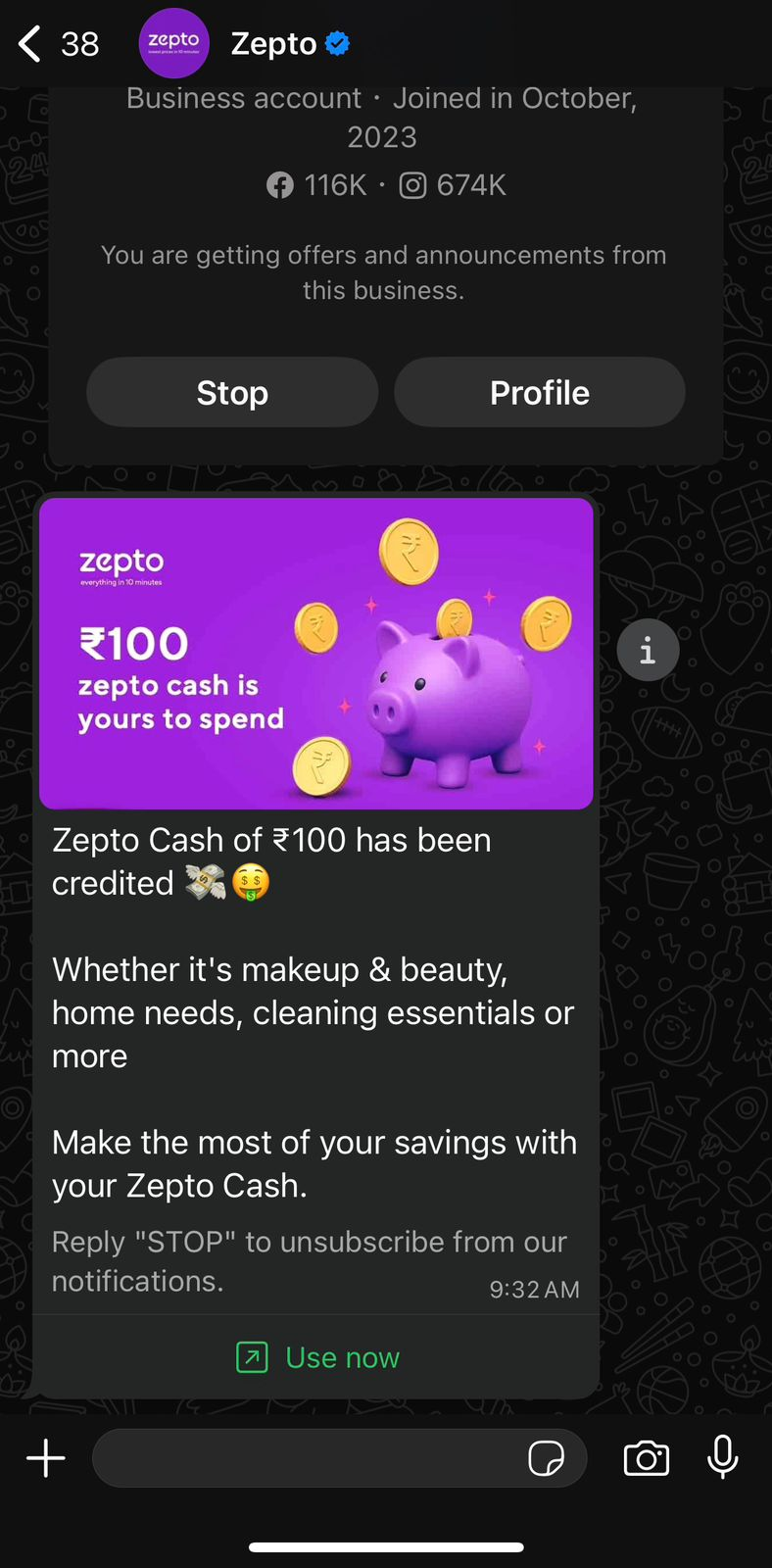
Pro Tip: Personalize loyalty reminders such as “You’re only 20 points away from your next reward!” to motivate repeat purchases and strengthen brand loyalty.
7. Back-in-Stock and Price-Drop Triggers
Few things frustrate customers more than finding a product they love, only to see it sold out or priced too high. Back-in-stock and price-drop triggers on WhatsApp turn this frustration into an opportunity.
By sending real-time alerts when items are available again or when prices fall, you capture intent at the exact moment.
Example: Nykaa, a beauty and cosmetic brand, triggers a WhatsApp message whenever there is a price drop in their cart, nudging them to make the purchase they stopped midway with.
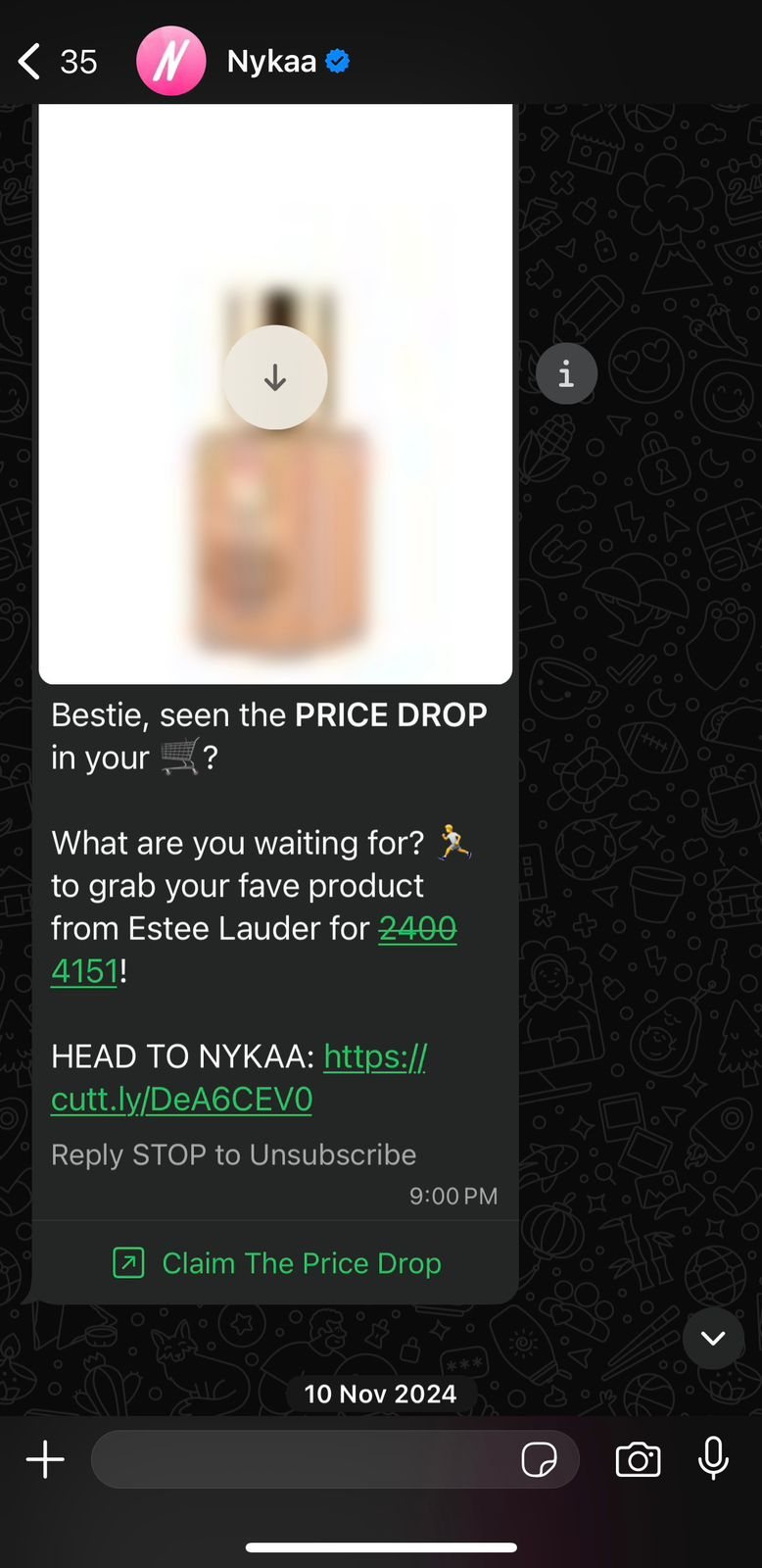
Pro Tip: Create urgency in these alerts with limited-time messages like “Hurry, only a few left!” to drive faster conversions.
8. Bundles, Cross-Sells, and Add-Ons After Intent
When a customer shows intent like adding an item to their cart or inquiring about a product, that’s the perfect time to suggest bundles, cross-sells, or add-ons.
The best part is that on WhatsApp, these recommendations feel like helpful guidance rather than aggressive upselling. As a result, brands can simply help customers to see added value while boosting their average order value.
Example: A customer shopping at a sportswear brand adds running shoes to their cart. Right after, the brand sends a WhatsApp message suggesting a bundle with moisture-wicking socks and a fitness tracker at a special price. With a single tap, the shopper can upgrade their order and check out.
Pro Tip: Time these suggestions right after intent is shown, so the recommendations feel like natural extensions of the customer’s purchase journey.
9. Click-to-WhatsApp Ads (CTWA) and AI Flows
Click-to-WhatsApp Ads (CTWA) are one of the most effective ways to bring potential buyers straight from discovery to conversation. Instead of sending users to a landing page with high drop-off rates, CTWAs open a WhatsApp chat instantly.
Pair this with AI-powered flows, and you can qualify leads, answer FAQs, showcase products, or even guide customers to checkout.
Example: An electronics brand runs a Facebook ad for “Laptops under $700.” When a shopper clicks, they’re taken directly to WhatsApp, where an AI assistant asks a few quick questions about specs and usage. Based on answers, it shares 2–3 matching laptops and generates a ready-to-buy cart.
Pro Tip: Keep your AI flows short and engaging. Long questionnaires can feel robotic, but 2–3 well-framed questions can drive faster conversions.
10. Cash on Delivery to Prepaid
Cash on Delivery (COD) may be convenient for customers, but it often leads to higher return rates and added costs for brands.
With WhatsApp, you can nudge COD customers to switch to prepaid orders through friendly, real-time conversations. Offering small incentives like discounts, loyalty points, or faster delivery makes the transition easy.
Example: Amazon, a renowned e-commerce brand, sends its COD customers messages urging them to pay online beforehand to ensure a smooth and contactless delivery experience.
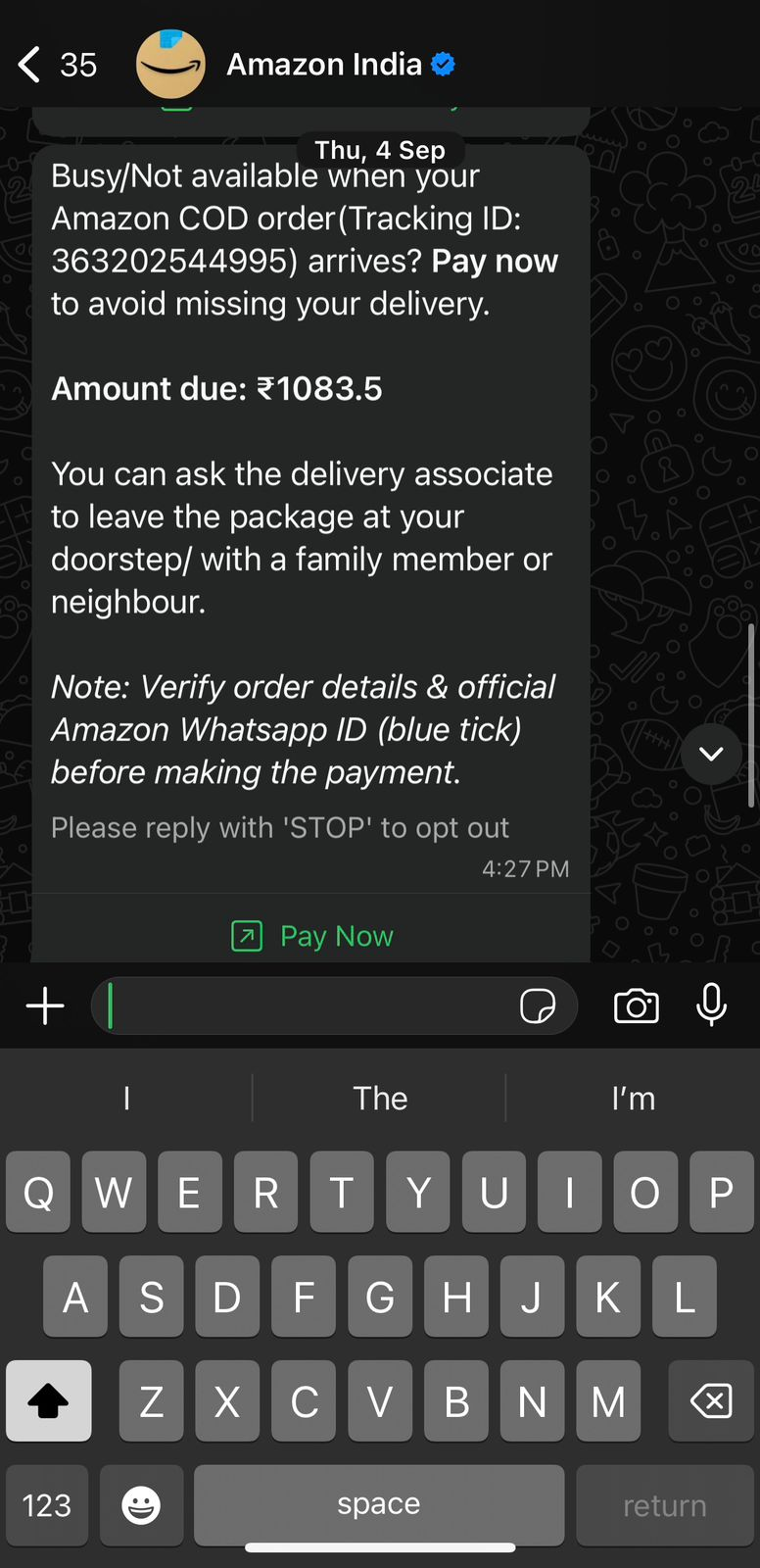
Pro Tip: Highlight benefits beyond discounts, like “faster delivery” or “contactless experience,” to make prepaid feel like the smarter choice, not just a cheaper one.
Best Practices for WhatsApp Conversational Marketing
While these are effective WhatsApp marketing strategies for inculcating conversational marketing in your everyday marketing tactics, here are some best practices to create a customer-first experience:
1. Consent First
Always start with explicit permission. A clear opt-in ensures compliance and builds trust. Customers should feel like they’re engaging with you by choice, not being spammed.
2. Start With Intent, Then Personalize
Leverage context for your customers, like the source a customer came from or the product they recently viewed or bought. This makes your messages more relevant and reduces drop-offs, as customers see value instantly.
3. Use Short, Tappable Choices
Instead of overwhelming customers with long menus, give them up to three quick options within the chat. This keeps the experience smooth and feels more like a conversation than a catalog.
4. Stop When the Job is Done
Once the cart is sent and paid for, close the journey. Over-communicating or pushing too many offers after conversion can frustrate customers rather than delight them.
5. Make Opt-Out Simple
Provide a clear Pause button that empowers users to instantly stop brand communications, ensuring they only receive messages when they truly want them.
6. Test Small, Measure Right
Experiment with templates, timings, and incentives on a small scale before rolling out widely. Instead of focusing solely on click-through rates (CTR), consider measuring incremental revenue to track real impact.
Future Trends for WhatsApp Conversational Marketing
The future of WhatsApp conversational marketing lies in creating more human and hyper-local interactions. We can expect WhatsApp conversational marketing to interpret voice notes from customers. With that, there’s scope for businesses to send video replies to customers, demonstrating product demos or providing post-purchase guidance.
At the same time, hyper-local engagement can become another benefit of WhatsApp marketing, with businesses using language personalization to connect with customers in their preferred dialect. They might also begin sending customized regional offers that reflect local buying habits and location-based recommendations that make shopping feel instantly relevant.
Together, these trends will transform WhatsApp from a convenient support tool into a truly immersive shopping experience for customers.
Challenges for WhatsApp Conversational Messaging
While there are several advantages of incorporating WhatsApp conversational marketing, there are also certain challenges that businesses must navigate through, such as:
Balancing Personalization with Privacy
Customers love relevant recommendations and contextual replies, but they don’t want to feel “watched.” There is a thin line between personalization and intrusion, which, if crossed, can lose customer trust.
Striking the right balance means being transparent about data use and keeping interactions value-driven.
Scaling Without Losing the Human Touch
Automation and AI can handle repetitive queries efficiently, but they often miss the empathy and nuance of a real human. This gap can leave customers feeling like they’re talking to a machine instead of a brand that cares.
Use a hybrid approach that uses bots for basics, humans for complex cases.
Avoiding Message Fatigue
While WhatsApp is a high-engagement channel, overloading customers with notifications can easily backfire. Too many offers or irrelevant pings may cause them to mute, opt out, or block your number.
The key lies in timing, relevance, and respecting customer preferences.
Technical Complexity
Setting up conversational flows, integrating with CRMs, and enabling payment gateways inside WhatsApp can be challenging for many businesses. Without the right tools or expertise, campaigns risk being clunky or ineffective, which can frustrate both teams and customers.
Utilize no-code WhatsApp automation platforms such as Flowcart to create seamless conversational flows with minimal technical effort.
Tools and Platforms for WhatsApp Conversational Marketing
To make WhatsApp conversational marketing effortless and seamless, you must incorporate the right tools. With the right platform to back you up, engaging in WhatsApp conversational marketing will become automated and scalable for you. Here are the top tools you can use:
1. Flowcart
(add an interactive demo)
Flowcart is an AI-powered conversational commerce and CRM platform that empowers e-commerce owners to transform the customer journey right from acquisition and checkout to retention, all within WhatsApp. This platform helps you guide your customers from the moment they say hi until they check out and make a payment with a dynamic self-service menu.
Not just this, your customers also have the option to get their query transferred to a human executive seamlessly whenever they want.
Flowcart also enables you to convert clicks into cart with a preloaded WhatsApp flow instantly, support customers to build checkout-ready carts, encourage customers to recover carts with context-aware WhatsApp nudges, and even send out tailored WhatsApp campaigns.
Key Features
Here are the top features of Flowcart that make it the trusted platform for 300+ companies globally:
- Dynamic Segmentation and Smart Broadcasts: Instead of broadcasting a one-size-fits-all message, you can segment customers based on life cycle (new vs repeat, past behaviors) and send targeted campaigns with Flowcart Smart Broadcasts.
- In-Chat Checkout and Conversational Catalogue: Users can browse catalogues, select items, and pay within the WhatsApp conversation with In-Chat Checkout. Flowcart’s UI supports buttons, carousels, and dynamic menus, so the experience is interactive and feels curated.
- No-Code Flow Builder and Analytics: You can build flows without coding. Also, dashboards show how many people are replying, adding to carts, converting, etc., letting you see what works.
- Retention with Loyalty and Gamification: Flowcart helps boost repeat purchases with built-in loyalty programs, reward points, and gamified experiences that keep customers engaged over time.
Pricing
Flowcart has customized pricing plans catering to all businesses, whether you are a growing business exploring conversational marketing or a large enterprise. Here are its four Flowcart pricing options:
- Starter: $69.99/month
- Growth: $129.99/month
- Pro: $199.99/month
- Enterprise: Custom
Ready to kickstart your WhatsApp conversational marketing journey? Start a free trial now!
Customer Testimonial
Flowcart makes all your WhatsApp flows so effective that you can see results instantly. Here is what Sneha Mehta, CEO of Uncover Skincare, has to say about their experience of using Flowcart:
“With Flowcart's conversational commerce solution, we can now engage customers directly within their preferred messaging apps, answer their questions, and guide them through the purchase process. This has significantly improved our conversion rates, especially in the beauty and wellness industry, where personalised advice is key.”
Discover how others are using Flowcart to meet their unique needs. Explore real success stories in Flowcart Case Studies.
2. WATI
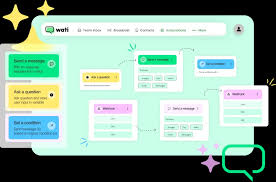
WATI is a WhatsApp Business API-based solution built for customer support and engagement at scale. It’s especially valuable for teams that need to handle large volumes of conversations without losing personalization.
Key Features
Here are the key features of WATI:
- Collaborative Team Inbox: A multi-agent inbox that lets teams assign, track, and resolve chats together with full visibility.
- Personalized Broadcast Campaigns: Send mass updates with customer-specific details to increase relevance and engagement.
- No-Code Chatbot Builder: Create bots that handle FAQs or repetitive queries automatically, saving time for agents.
- CRM and App Integrations: Seamlessly connect with existing tools to unify customer data across channels.
3. Zoko
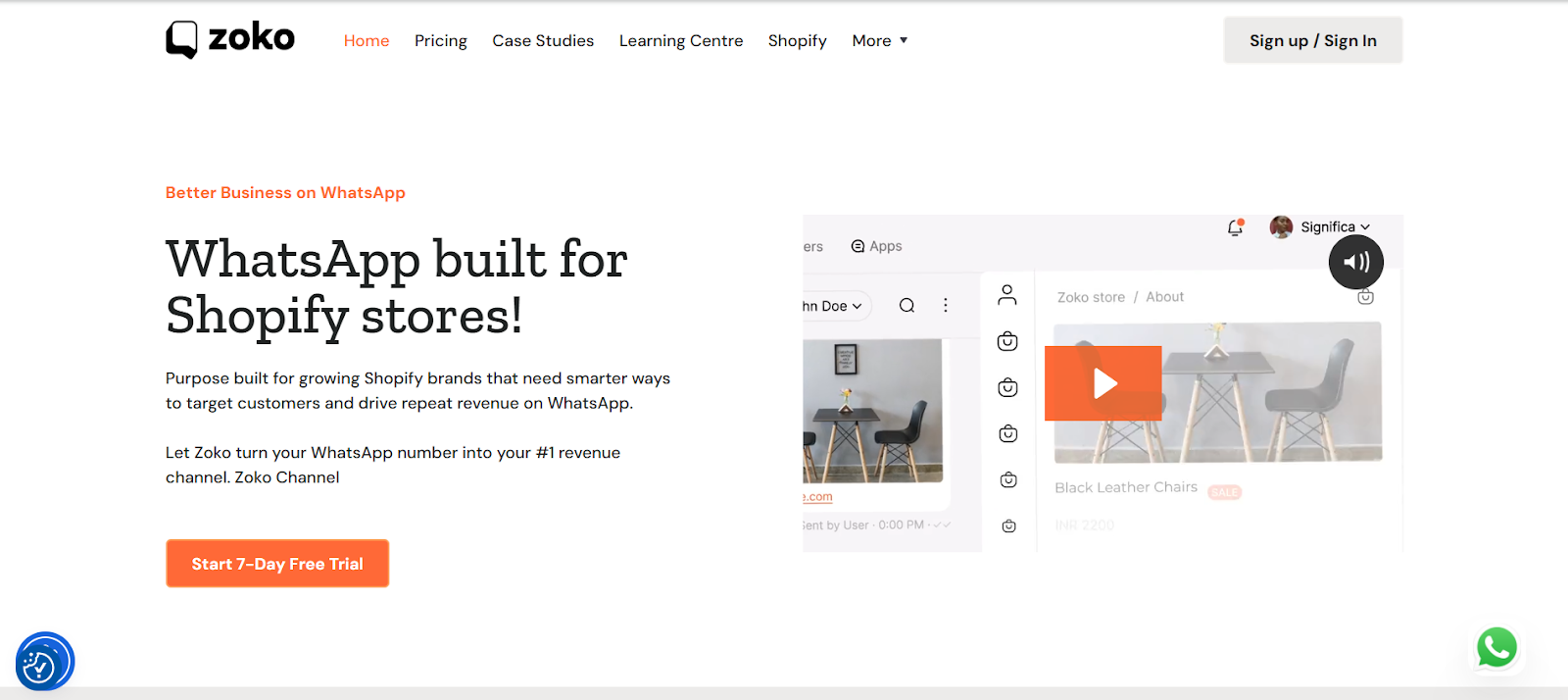
Zoko turns WhatsApp into a complete sales and marketing engine, blending chat, payments, and automation in one platform. Its real strength lies in enabling direct in-chat transactions, reducing drop-offs at checkout, and driving instant sales for ecommerce brands.
Key Features
Here are the key features of Zoko:
- Unified Sales and Support Inbox: Manage conversations, orders, and notifications from one streamlined interface.
- Native Payment Collection: Collect payments directly inside WhatsApp without redirecting customers elsewhere.
- Smart Campaign Segmentation: Target promotions to customer groups based on purchase history or behavior.
- Automated Cart Recovery: Re-engage shoppers with timely, contextual nudges to complete their purchases.
4. Respond.ai
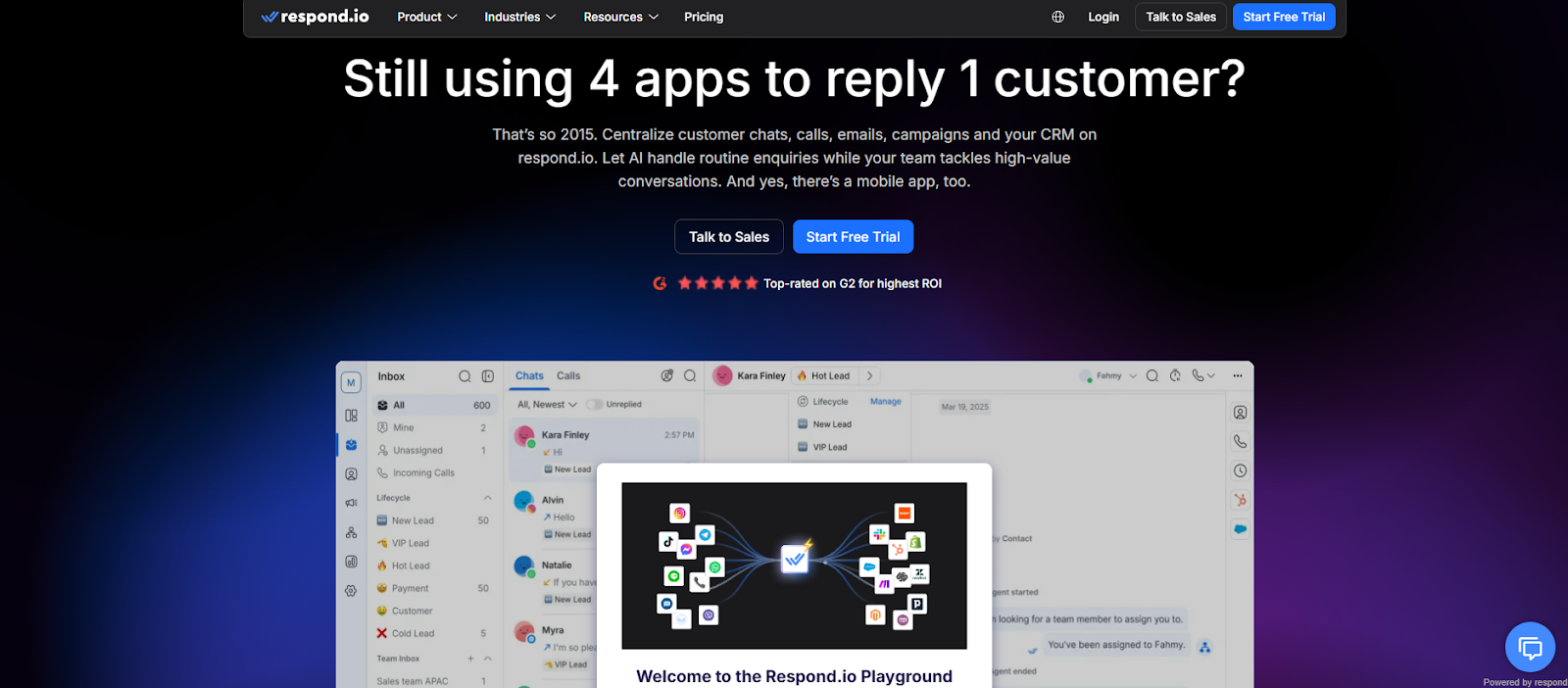
Respond.io is a conversation management hub that connects WhatsApp with multiple messaging channels like Messenger, Telegram, and LINE. It stands out by bringing all customer interactions into one dashboard, making it easier for businesses to deliver fast, data-driven support and marketing.
Key Features
Here are the key features of Respond.ai:
- Omnichannel Conversation Inbox: Manage WhatsApp, Messenger, and other channels in one place for efficiency.
- Advanced Automation Workflows: Trigger replies, routes, or actions automatically based on intent or events.
- Comprehensive Analytics: Access reporting tools that map the customer journey and measure conversions.
- CRM and Marketing Integrations: Connect to Salesforce, HubSpot, and more to sync customer profiles.
Conclusion
Conversational WhatsApp marketing is slowly becoming the most significant channel for modern brands to contact and persuade their customers. When used thoughtfully, it allows brands to meet customers where they are, spark meaningful interactions, and turn casual chats into lasting relationships.
With the right balance between human touch and AI automation, businesses can achieve stronger engagement and higher conversions.
FAQ'S
What is WhatsApp conversational marketing?
It’s a marketing approach that uses real-time, two-way chats on WhatsApp to engage customers, answer queries, and drive purchases directly within the app.
Why is WhatsApp effective for conversational marketing?
WhatsApp has a 98% open rate and supports instant, personalized communication, making it far more engaging than traditional channels like email or SMS.
Can small businesses use WhatsApp for sales?
Yes. With tools like Flowcart, small businesses can automate conversations, recover carts, and manage sales efficiently without large teams.
How do I measure success in WhatsApp marketing?
Track engagement metrics such as open rates, response times, conversions, and revenue impact using analytics dashboards from platforms like Flowcart.
Is WhatsApp marketing expensive to set up?
Not necessarily. Tools like Flowcart offer tiered pricing plans, allowing you to start small and scale as your customer base grows.
.png)


.png)
.png)


%201.webp)



